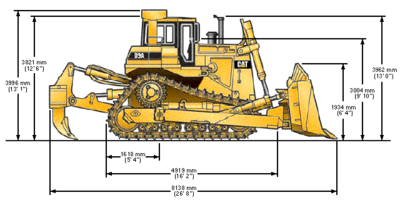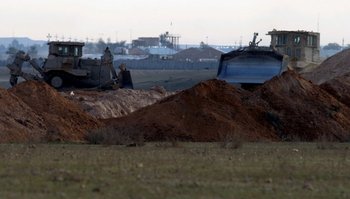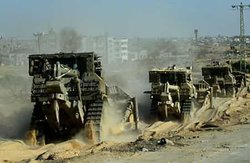Caterpillar D9
|
|
 | |
| Caterpillar D9 - General Characteristics | |
| Engineering Role: | Heavy bulldozer |
| Propulsion: | Caterpillar tracks |
| Engine model: | CAT C18 ACERT
(D9T) 3408 HEUI (D9R) |
| Gross power: | 346 kW (464 hp) D9T 354 kW (474 hp) D9R |
| Flywheel power: | 306 kW (410 hp) D9T 306 kW (410 hp) D9R 280 kW (375 hp) D9N 343 kW (460 hp) D9L |
| Operation Weight: | 48784 kg (107548 lb) | Length: | 8.1 m |
| Width: | 4 m (blade) |
| Height: | 4 m |
| Speed: | 11.9 km/h (forward) 14.7 km/h (reverse) |
| Blade capacity: | 13.5 m³ (17.7 yd³) 9 SU blade 16.4 m3(21.4 yd³) 9 U blade |
The Caterpillar D9 is a large track-type tractor (commonly referred to as a bulldozer) with caterpillar tracks designed and manufactured by Caterpillar Tractor Company.
The D9, with 354 kW (474 hp) of gross power and an operating weight of 49 tons, is in the upper end, but not the heaviest, of Caterpillar's track-type tractors, which range in size from the D3 57 kW (77 hp), 8 tons, to the D11 698 kW (935 hp), 104 tons.
The D9 is mostly used as bulldozer, and though it comes in many configurations, it is mostly common in its basic dozer configuration: equipped with a detachable large blade and a rear ripper. The size, durability, reliability, and low operating costs has made the D9 one of the most popular large track-type tractors in the world, with the Komatsu D275A as one of its most direct competitors. The D-9 gained high media attention in the new millennium due to its military applications by the Israeli Defence Forces.
| Contents |
Engineering and technical description
Caterpillar_D9.JPG
The D9 is a series of heavy tracked-type tractors, propelled by Caterpillar tracks and usually used as bulldozers. The D9 has undergone several generations of engineering enhancements. Each new generation is denoted with an English letter added to "D9". Until the introducing of the D10 in the 1980's, the D9 was the largest conventional CAT dozer. The D9L was the first variation of the D9 to employ "High-Drive" design in which the driving wheel is located above the track wheels, and not in the same row. The High-Drive gives the "belly pan" more ground clearance. The current versions are the D9R and the D9T models, but older models such as the D9N and D9L are still common. The L, N, R and T models of the D9 are visually very similar, differing primarily in the design of their internal systems. The D9T main difference from the D9R is the installment of the new Cat C18 ACERT engine. The D9L was probably the most powerful D9 in history, with flywheel power of 460 hp.
The D9's primary working tools are the blade, affixed to the front and controlled by 6 hydraulic arms, and the optional ripper, which can be attached to the back. The blade is mainly intended for earthmoving and bulk material handling: pushing up sand, dirt and rubble. It also can be used to push other heavy equipment such as earthmoving scraper pans, and in military applications, main battle tanks. The dozer blade usually comes in 3 varieties:
- A Straight Blade ("S-Blade") which is short and has no lateral curve, no side wings, and can be used for fine grading.
- A Universal Blade ("U-Blade") which is tall and very curved, and has large side wings to carry more material.
- A "S-U" combination blade which is shorter, has less curvature, and smaller side wings. This blade is typically used for pushing piles of large rocks, such as at a quarry.
Like many other bulldozers, the D9 can be fitted with different blades (such as size-9 SU blade and Universal blade) or other devices such as mineplows or combine harvester.
The rear ripper is intended for use in loosening rocky ground and ripping out larger stones. It can also break frozen ground and excavate small ditches. The ripper can be replaced with a multi-shank ripper, allowing the bulldozer to comb the ground.
The size, power and weight of the larger track-type tractors dictate that they are used primarily for major projects. The D9 is most commonly found in use in construction, forestry, mining, waste, and quarry operations.
Military applications
Caterpillar Inc. does not manufacture a military version of the D9 per se, but the attributes that make the D9 popular for major construction projects make it desirable for military applications as well, and in this role - with Israeli modifications and armor - it has been particularly effective for the Israel Defense Forces (IDF) and later for the United States armed forces (the Marine Corps and the US Army) in Iraq.
Israel
Armored bulldozers are a standard tool of Combat engineering battalions, and the IDF has gained some notoriety for their use of armored tractors for urban warfare in the Al-Aqsa Intifada. Although the Israeli Engineering Corps has used D9 bulldozers since the 1960s (including in the Six Day War and Yom Kippur War), the D9 first rose to public attention in April 2002 during Operation Defensive Shield, later when D9s were used to demolish structures and shrubbery, and through involvement in such incidents as the death of Rachel Corrie. In Israel, the D9 has gained highly favorable reviews — both from the public and from the armed forces — for keeping IDF casualties low and for saving the lives of soldiers.
D9R-idf.jpg
Its armor allows it to work under heavy fire.
The Israeli Armored D9 — nicknamed Dooby (lit. teddy bear) — is a Caterpillar D9 tractor that was modified by the IDF and Israeli Defense Industries to increase the survivability of the dozer in hostile environments and enable it to withstand heavy attacks. The main IDF modification is the installation of an Israeli-made armor kit which provides armor protection to the mechanical systems and to the operator cabin. The operator is protected inside an armored cabin, with bulletproof windows to protect against bombs, machinegun and sniper fire. The IDF also developed an armor add-on to deflect RPG rounds. The fitted armor package adds roughly 15 additional tons to the production-line weight of the D9. As for many customized packages, individually modified D9s may be found with disparate features, such as crew-operated machine guns, smoke projectors, or grenade launchers. The heavy armor carried by modified D9s allows them to work under heavy fire in dangerous battle-zones and resist mine blasts. The Israeli armor kit has proven to be effective, as no D9 operator was killed during the 4-year long al-Aqsa Intifada.
The Israeli Engineering Corps uses the D9 for a wide variety of engineering tasks, such as digging moats, clearing mines, mounting sand barriers, building fortifications, clearing terrain obstacles and opening routes to Armored fighting vehicles and infantry. On Yom Kippur War the D9s took part in the breaching of the Suez Canal, enabling Israeli forces to go through the canal and surround the Egyptian 3rd Army. In the northern front an Israeli D9 opened a route in the snow to elite infantry forces. It was the first ever motorized vehicle to reach the highest peak of Mount Hermon. One of the D9's primary roles is to clear landmine fields and booby-trapped areas. It can do it either by the regular heavy blade or by specially-designed mineplows attached in the front.
In urban warfare and counter-terror operations, the D9s has also been used in standoff situations with armed opponents barricaded in buildings, usually rigged with explosives and booby-traps, when no hostages are present. In order not to risk Israeli soldiers, the D9 shakes the house until the barricaded gunmen surrender. After the building is evacuated, the D9 razes the structure in order to detonate and bury any explosives that remain inside. Hamas chief bombmaker and the plotter of the Passover massacre, Case Aduwan, was killed in April 7, 2002, after he was tracked by the SHABAK and the YAMAM and a D9 destroyed the house he was hiding after heavy exchanges of fire. In Hebron, the IDF used the armored D9 to stop the local Hamas leader, Bassal Qawasameh, who shot at the D9 with machinegun, but was killed when the D9 demolished the house where he was hiding. One year after, Imad Qawasameh (who planned the Beer Sheva twin suicide bombing) surrendered to IDF forces, after a D9 started demolishing his house.
This method was also employed vastly in Jenin during Operation Defensive Shield after 13 Israeli soldiers were killed in an ambush, resulting in the surrender of dozens of gunmen without further Israeli casualties. D9s were used in Jenin also to clear booby traps and open rigged doors. Palestinian terrorists who fought in Jenin admitted (http://www.time.com/time/2002/jenin/story.html) it was the D9 that won the battle as it was impervious to their attacks - including large bombs and Rocket propelled grenades (RPGs). See more details at Battle of Jenin 2002.
Armored D9 bulldozers are routinely employed in the Gaza strip as well. Their main tasks there are to detonate large explosive charges (such as improvised anti-tank landmines,booby traps and IEDs) and clear safe paths for IDF armored fighting vehicles and troops. The D9s also demolish houses and clear shrubbery that terrorists can use as shooting, shelling or bombing cover. The D9s are an essential tool in the IDF campaign against smuggling tunnels in Rafah, which are used by terrorists to smuggle weapons, persons and contraband. Armored D9 bulldozers have demolished many structures in Rafah during battles with terrorists and operations to uncover smuggling tunnels.
The destruction of hundreds of structures in Rafah is a highly controversial issue. The Israel Defense Forces claim that the destruction of buildings and tunnels is a security necessity and that most houses destroyed were used for terrorist activity. However, Palestinians claim that the destruction has left thousands of people homeless, and is done systematically in order to create a cleared "buffer zone" between Rafah and Philadelphi Route. Protests against this destruction have caused further controversy, through such as incidents as the death of Rachel Corrie.
Human Rights Watch has published a report (http://www.hrw.org/campaigns/gaza) criticizing the mass demolition in Rafah, in which it argues against many of the IDF's justifications for the destructive activities carried out by D9s. HRW supports Palestinian claims that the existence of tunnels (http://www.hrw.org/reports/2004/rafah1004/6.htm#_Toc84676183) in Rafah is simply being used as a pretext to demolish homes in order to create a "buffer zone". HRW believes that instead of using available and effective technologies for neutralizing tunnels where they cross the border, the IDF is instead undertaking unnecessary and highly destructive incursions into the camp. HRW's report also contends that the extensive destruction of roads (http://www.hrw.org/reports/2004/rafah1004/14.htm#_Toc84676206), water, and sewage networks by D9 bulldozers is not plausible as an antimine technique, as most of the destruction is wrought using the rear blade of the bulldozer, which would do nothing to protect bulldozers from improvised explosive devices. Instead, HRW claims that the IDF destruction of roads, utilities and civilian structures is vindicative, punitive and illegal. HRW has called on Caterpillar Inc. to suspend sales of D9s and related parts and services to the IDF so long as illegal demolitions continue. The Israeli position regarding operation Rainbow (http://www.mfa.gov.il/mfa/mfaarchive/2000_2009/2004/5/behind%20the%20headlines%20-%20rafah%20gateway%20to%20terrorism) described Rafah as the "Gateway to terrorism". The IDF stressed that "... the IDF traditionally does its utmost to avoid harming the civilian population. It employs infantry forces whenever possible – as opposed to air or artillery strikes – to minimize the possibility of doing unintentional harm. At times, this humanitarian concern comes at the price of risking the lives of soldiers – two of whom were killed last week by Palestinian snipers while helping an elderly woman get food" and claimed that most demolition are carried out against houses which are used by terrorists to shot at IDF forces, and were approved by the Israeli Supreme Court of Justice: "Even though these demolitions were the direct result of terrorist activity – and were thus the responsibility of the terrorists themselves – 46 Palestinian families involved exercised their right to appeal the demolitions to Israel’s High Court of Justice this week. In ruling to allow the demolitions, the court noted that they were permissible due to the overriding need to protect the lives of Israelis."
D9s also took part in demolition of houses of suicide bombers. According to the IDF, the policy of destroying the homes of Palestinian suicide bombers has been established in response to terror groups, backed by countries such as Iran, Saudi Arabia and Saddam Hussain's Iraq, offering monetary rewards to Palestinian families who have family members die as suicide bombers. Destroying those homes removes monetary gain as a motive to kill. The house demolition role has been executed with much success by D9s, excavators, and the Israeli Engineering Corps demolition experts.
Both military armored D9s and civilian non-armored D9s are being used by Israel's Ministry of Defense in the building of the Israeli West Bank barrier. The main D9 contributions to the project are earthmoving and soil-leveling, clearing a path for the security fence, and digging trenches in front of the security fence.
United States

The United States Army has purchased several D9 armor kits from the IDF and used them to produce similarly fortified D9s. These have been used to clear destroyed vehicles from roads, dig moats, erect earthen-barriers, and construct field fortifications. D9s have also been used to raze houses which hosted snipers who shot at American forces (similar to the Israeli usage). There were some reports about the use of large bulldozers against Iraqi trenches during the first Gulf War. Military reports on the Conflict in Iraq say that the D9s were found very effective and "received highly favorable reviews from all that benefited from their use" (Field Report: Marine Corps Systems Command Liaison Team , Central Iraq , 20 April to 25 April 2003).
The US army used D9 bulldozers to clear wood in Vietnam war but after the war it replaced them with smaller and cheaper Caterpillar D7 bulldozers. D7 dozers are still very common in US combat engineering battalions, but there is a resurgent high demand to replace the lighter D7s with the newer and more heavily armored D9s.
See also
External links
Civilian D9 bulldozer
- Caterpillar Tractor Company - Official Website (http://www.cat.com)
- Caterpillar D9T (http://cmms.cat.com/cmms/servlet/cat.dcs.cmms.servlet.GetModelSummary?dsfFlag=0&&classid=406&langid=en&rgnid=NACD&view=cat&prdname=D9T&prdid=D9T+2&familyid=482&subfamilyid=322&subfamilyheader=Track-Type+Tractors), CAT website
- Pictures of CAT D9N bulldozer (http://www.atst.ru/cat9b.jpg).
- Book "Caterpillar D9 - D9R" by Thomas Wilk & Urs Peyer (http://www.classictractors.co.uk/shop/static/caterpillar_d9-d9r_720.htm)
- Review on the D9G (http://www.vannattabros.com/dozer4.html)
Military D9 bulldozer
- Army's new D9 bulldozer digs into duty in Kuwait (http://cndyorks.gn.apc.org/caab/articles/kuwait-dig.htm) - The US army tests the armoured D9R for the Iraqi campaign
- Engineering News: Combat Engineering in Iraq (http://www.enr.com/features/bizlabor/archives/030922.asp) - including reviews on the D9 Dozer performance in Iraq and nice pictures of it and other CEVs
- IDF D9 bulldozer (http://www.israeli-weapons.com/weapons/vehicles/engineer_vehicles/bulldozers/D9_D10.html) (Israeli-Weapons website)
- "IAI/Ramta Begins Deliveries of Armor Protected Caterpillar D9R Dozers under Contract Option Exercised by IDF" (14 June 2004) (http://www.iai.co.il/site/en/iai.asp?pi=23048&doc_id=31739) (The Israeli Aerial Industries)
- Pictures of "Duby", IDF armoured D9 (http://www.jedsite.info/engineer/charlie-caterpillar/d9r_series/israeli-armoured/israrm-intro.html) (Jed Army Recognition)
- AP: Israel to Raze With Robot Bulldozers (30 October 2003) (http://www.timesleader.com/mld/timesleader/news/7144048.htm) - "The giant Caterpillar bulldozer, used by the Israeli military to destroy Palestinian homes in the West Bank and Gaza Strip, now comes with a controversial new feature: remote control."
- Human Rights Watch criticizes mass demolitions in Gaza, citing the Caterpillar D9 as the main tool (http://www.hrw.org/reports/2004/rafah1004/index.htm)
- The Battle of Jenin, 2002:
- "Time" account on the battle of Jenin and how the D9s won the battle (http://www.time.com/time/2002/jenin/) (Time Magazine article)
- Interview with "Kurdi Bear", a D9 operator who fought in Jenin refugee camp in April 2002 (http://www.gush-shalom.org/archives/kurdi_eng.html)
- Interview with the commander of the D9s unit and three D9 operators who fought in Jenin refugee camp in April 2002 (http://www.fresh.co.il/dcforum/Army/7506.html#9) (scanned, Hebrew)he:דחפור די-9

